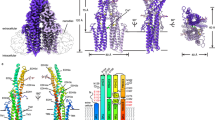Abstract.
We have cloned a novel member of the tandem pore K+ channel family from human brain cDNA. The novel cDNA encodes a 330-residue polypeptide of predicted molecular mass 36 kDa. We have named the channel TASK-5 owing to its sequence homology with TASK-1 and TASK-3. TASK-5 mRNA is expressed in pancreas, liver, kidney, lung, ovary, testis and heart. However, expression of TASK-5 in heterologous systems failed to elicit ionic currents. Removal of a putative endoplasmic reticulum retention sequence did not alter this finding and the distribution of channel proteins in HEK293 cells was similar for both TASK-1 and TASK-5. We tested whether TASK-5 could form heteromers with TASK-1. We show a mutant form of TASK-1 (H98N) to have a radically reduced sensitivity to acidification. Proton sensitivity could be rescued by injecting equimolar amounts of wild-type and mutant TASK-1 cRNA into Xenopus oocytes; the effect was that expected if half the channels formed are heteromers. Co-expression of TASK-5 with TASK-1 H98N does not affect the proton sensitivity of mutant TASK-1; thus TASK-5 appears not to form heteromers with TASK-1. Nonetheless, TASK-5 may require some other, unidentified partner subunit to form functional channels in the plasma membrane or it may form a channel in an intracellular organelle.
Similar content being viewed by others
Author information
Authors and Affiliations
Additional information
Electronic Publication
Rights and permissions
About this article
Cite this article
Ashmole, I., Goodwin, P.A. & Stanfield, P.R. TASK-5, a novel member of the tandem pore K+ channel family. Pflügers Arch - Eur J Physiol 442, 828–833 (2001). https://doi.org/10.1007/s004240100620
Received:
Accepted:
Issue Date:
DOI: https://doi.org/10.1007/s004240100620



